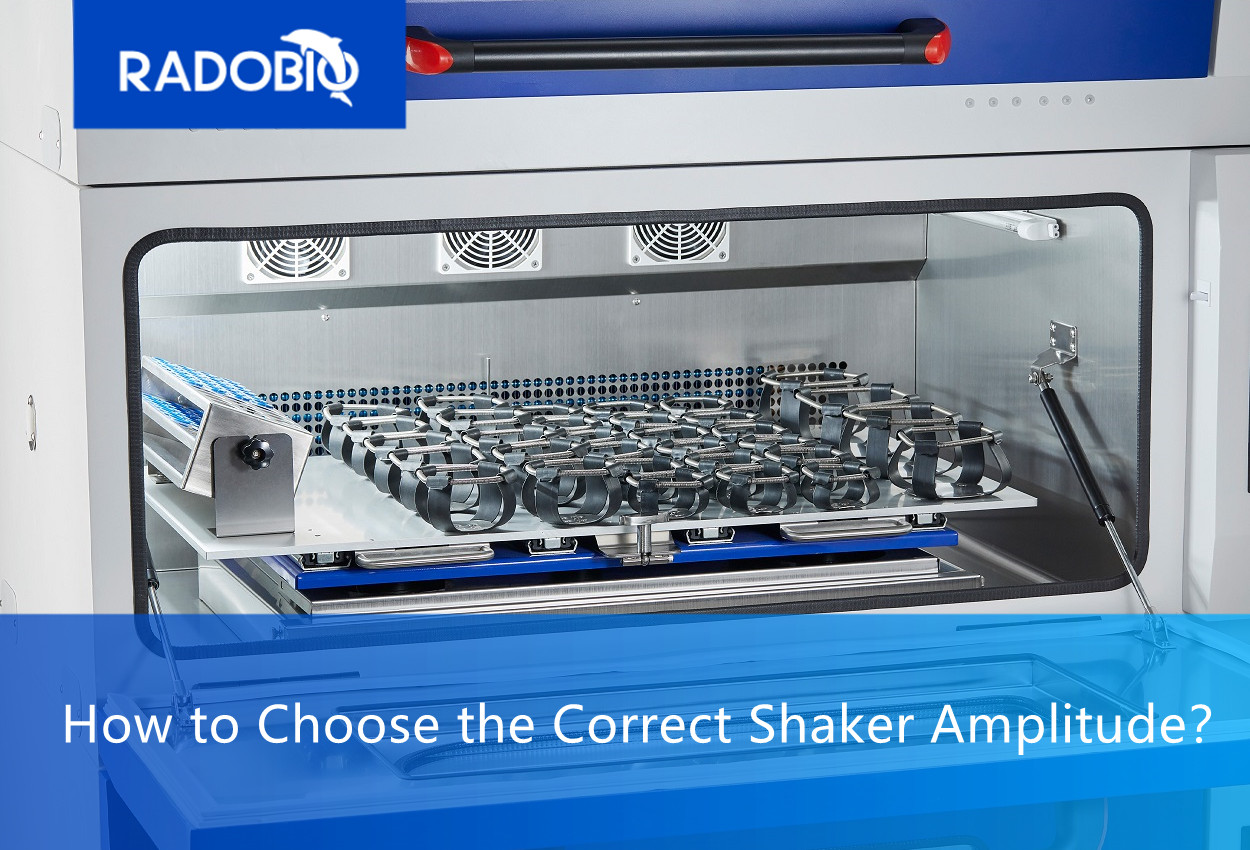How to Choose the Correct Shaker Amplitude?
What is the amplitude of a shaker?
The amplitude of a shaker is the diameter of the pallet in circular motion, sometimes called the “oscillation diameter” or “track diameter” symbol: Ø. Radobio offers standard shakers with amplitudes of 3mm, 25mm, 26mm and 50mm,. Customized shakers with other amplitude sizes are also available.
What is Oxygen Transfer Rate (OTR)?
Oxygen Transfer Rate (OTR) is the efficiency of oxygen is transferred from the atmosphere to the liquid. The higher the OTR value means the higher the oxygen transfer efficiency.
Effect of Amplitude and Rotation Speed
Both of these factors affect the mixing of the medium in the culture flask. The better the mixing, the better the oxygen transfer rate (OTR). Following these guidelines, the most suitable amplitude and rotational speed can be selected.
In general, selecting a 25mm or 26mm amplitude can be used as a universal amplitude for all culture applications.
Bacterial, yeast and fungal cultures:
Oxygen transfer in shake flasks is much less efficient than in bioreactors. Oxygen transfer may be the limiting factor for shake flask cultures in most cases. The amplitude is related to the size of the conical flasks: larger flasks use larger amplitudes.
Recommendation: 25mm amplitude for conical flasks from 25ml to 2000ml.
50 mm amplitude for conical flasks from 2000 ml to 5000 ml.
Cell Culture:
* Mammalian cell culture have a relatively low oxygen requirement.
* For 250mL shaker flasks, sufficient oxygen delivery can be provided over a relatively wide range of amplitudes and speeds (20-50mm amplitude; 100-300rpm).
* For larger diameter flasks (Fernbach flasks) an amplitude of 50mm is recommended.
* If disposable culture bags are used, 50mm amplitude is recommended.
Microtiter and deep-well plates:
For microtiter and deep-well plates there are two different methods to obtain maximum oxygen transfer!
* 50 mm amplitude at a speed of not less than 250 rpm.
* Use 3mm amplitude at 800-1000rpm.
In many cases, even if a reasonable amplitude is chosen, it may not increase the bioculture volume, because the increase in volume can be influenced by several factors. For example, if one or two of the ten factors are not ideal, then the increase in culture volume will be limited no matter how good the other factors are, or it could be argued that the correct choice of amplitude will result in a noticeable increase in the incubator if the only limiting factor for culture volume is oxygen delivery. For example, if the carbon source is the limiting factor, no matter how good the oxygen transfer is, the desired culture volume will not be achieved.
Amplitude and Rotation Speed
Both amplitude and rotational speed can have an effect on oxygen transfer. If cell cultures are grown at very low rotational speeds (e.g., 100 rpm), differences in amplitude have little or no noticeable effect on oxygen transfer. To achieve the highest oxygen transfer, the first step is to increase the rotational speed as much as possible, and the tray will be properly balanced for speed. Not all cells can grow well with high speed oscillations, and some cells that are sensitive to shear forces may die from high rotational speeds.
Other influences
Other factors can have an effect on oxygen transfer:.
* Filling volume, conical flasks should be filled to no more than one third of the total volume. If maximum oxygen transfer is to be achieved, fill to no more than 10%. Never fill to 50%.
* Spoilers: Spoilers are effective in improving oxygen transfer in all types of cultures. Some manufacturers recommend the use of “Ultra High Yield” flasks. The spoilers on these flasks increase liquid friction and the shaker may not reach the maximum set speed.
Correlation between amplitude and speed
The centrifugal force in a shaker can be calculated using the following equation
FC = rpm2 × amplitude
There is a linear relationship between centrifugal force and amplitude: if you use a 25 mm amplitude to a 50 mm amplitude (at the same speed), the centrifugal force increases by a factor of 2.
A square relationship exists between centrifugal force and rotational speed.
If the speed is increased by a factor of 2 (same amplitude), the centrifugal force increases by a factor of 4. If the speed is increased by a factor of 3, the centrifugal force increases by a factor of 9!
If you use an amplitude of 25 mm, incubate at a given speed. If you wish to achieve the same centrifugal force with an amplitude of 50 mm, the rotational speed should be calculated as the square root of 1/2, so you should use 70% of the rotational speed to achieve the same incubation conditions.

Please note that the above is only a theoretical method of calculating centrifugal force. There are other influencing factors in real applications. This method of calculation gives approximate values for operational purposes.
Post time: Jan-03-2024



 中文
中文
